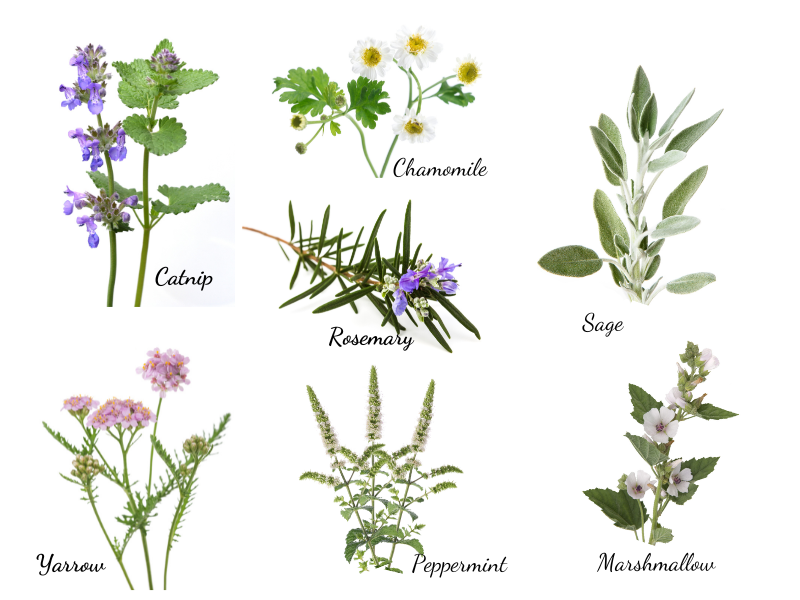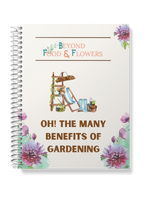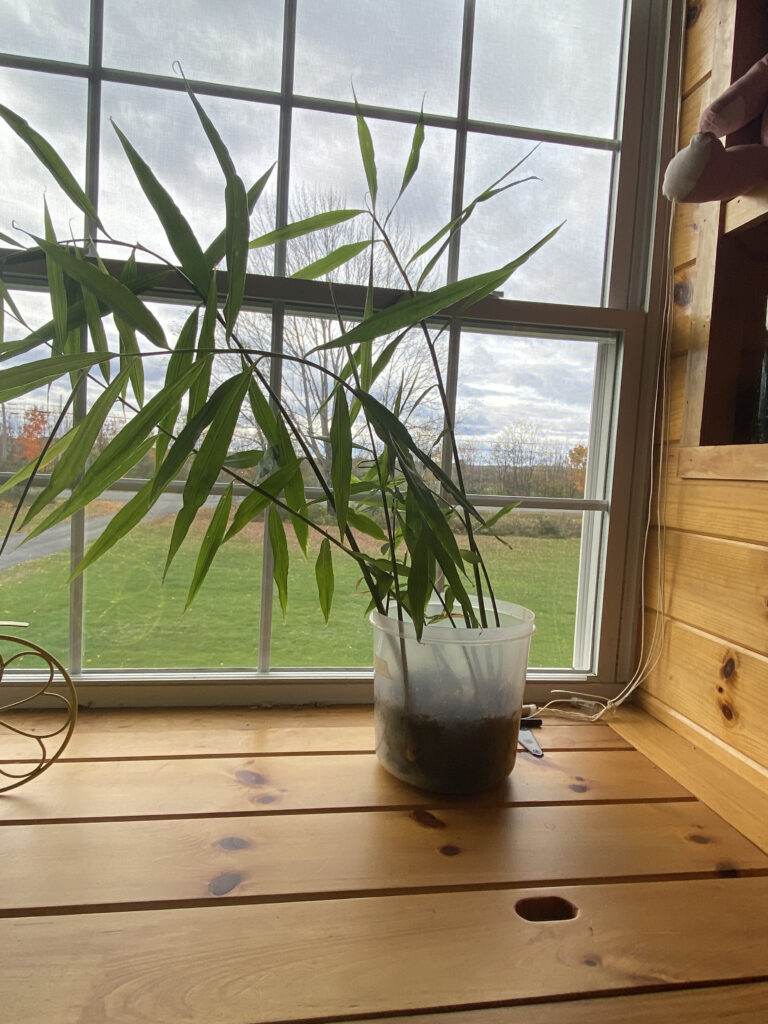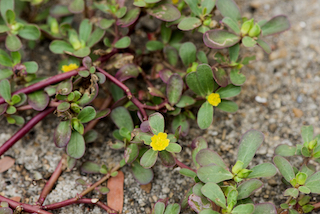7 EASY HERBS TO GROW FOR HEALTH
Here are 7 easy herbs to grow, for your health. These are all herbs I grow and use myself.
Please don’t go into using herbs thinking there is no way they could ever cause health problems. Plants are remarkably powerful when used properly. The thing is, I don’t know what medications your take, or your allergies, or health problems. I do believe we can all be very healthy using the plants God created for us – as long as we also use the wisdom He gave us.
So….I will try to provide as much information as I can here. Feel free to email me with questions, and always work with your herbalist or other healthcare provider as needed.

EASY HERB TO GROW FOR HEALTH #1
Catnip (Nepeta cataria)
Also known as catmint, is even better for humans than for cats. No. Catnip won’t make you wild. It’s actually very relaxing for people without giving you a buzz.

TAKE BACK YOUR VITALITY!
Learn more about the health benefits of gardening and get some good tips and instruction too.
Catnip is very safe for children, but use caution in pregnancy as it could possibly cause contractions.
It’s a bushy perennial that grows two or three feet tall and is hardy to at least zone 4. Catnip loves sun and well drained soil. I have some growing in my vegetable garden. It re-seeds itself there. but isn’t aggressive. It just keeps popping up here or there and I let it do what it wants.
Harvest:
Mid to late summer when the plants are in full bloom. Cut the flower stalks with the leaves and hang bunches around the house, or lay them on screens to dry. Then store in a jar with a lid out of direct sunlight.
Used For:
All things digestive. Catnip is great for nausea and gas. A little catnip tea does wonders for colic. Talk to your healthcare provider, but think in terms of 1/2 to 1 tsp of tea up to three times a day. Older children and adults can chew a couple fresh leaves or make a tea. Tooth pain and teething. Coughs and colds. To lift the spirit meaning to treat mild depression and anxiety. It’s especially useful taken before bed or when you feel the power surge of panic coming on. Sunburn and scrapes. To use for skin; make a cold tea and rinse the skin or pour onto a cloth and lay the cloth on the burn.
EASY HERB TO GROW FOR HEALTH #2
Chamomile (Matricaria chamomilla)
Chamomile is another relaxing herb that can be used for all ages. It is safe in pregnancy in the form of a cup of tea. Avoid crazy large amounts in pregnancy. (Herbalists recommend its use but some medical studies raise questions.)
There are many different species of chamomile, but they all work the same way. Roman chamomile is a perenial and German chamomile is an anual that will keep coming back because it reseeds itself. It likes sunshine and well drained soil.
Harvest:
Keep picking the tiny flowers off. They will dry well on a tray or screen.
Used For:
Chamomile is a potent anti-inflammatory and a sedative, making it a great choice for pain relief when you also need to rest. Teething – Soak a well-rinsed washcloth in chamomile tea and let baby suck and chew on it. The cooling, soothing chamomile works well. Or freeze the tea in a teether. Bloating, Stomach Cramps, Heartburn and IBSall respond well to chamomile. Five drops of chamomile infused oil applied to an infant’s abdomen three times a day will relieve colic. (NOT ESSENTIAL OIL). The oil can also be made into a fantastic salve for wounds and stings. Muscle Spasms including menstrual cramps. For spasms, drink the tea or soak in a tub with chamomile added to the water. It’s good for fevers and even for seasonal allergies and colds.
EASY HERB TO GROW FOR HEALTH #3
Sage (Salvia officinalis)
Garden sage is a shrubby perenial to at least zone 5. I can sometimes get it to winter over where I am, but not always. It likes rich, well-drained soil and full sun. In colder climates, garden sage may be kept over the winter by covering with straw or mulch.
Avoid large amounts in pregnancy, and it may decrease milk supply in some women. Medicinal doses should be avoided if you have seizure disorder.
Harvest:
The longest stems may be harvested from June onward (in temperate climates) and the leaves may be harvested year round. Once harvested, hang stems to dry or dry the leaves and preserve whole until needed.
Used For:
Garden sage is very nutritious with Beta-carotene, vitamins B1, B2, B3, and C, calcium, iron, and magnesium. Stimulating digestive secretions, and it increases the flow of bile to improve the digestion of fats. Sage is also used to ease gas. Improves memory and thinking skills. Improves mood, fatigue and mental lethargy. It is antimicrobial and anti-inflammatory making it a good choice for colds, flu and seasonal allergies. Sage is also an expectorant so it thins mucus and phlegm. It helps stop hair loss. Because sage helps to tone tissue it is useful for snoring and sleep APNEA. Relieves excess sweating.
EASY HERB TO GROW FOR HEALTH #4
Rosemary (Salvia rosmarinus (syn. Rosmarinus officinalis))
Rosemary is a warm climate perennial. I grow it in a pot and bring it in for the winter. Depending on your climate and the particular variety of rosemary, it can grow from 2 to 6 feet tall. It likes sun and well-drained soil.
Harvest:
Harvest the leaves for fresh use any time. hang bunches of small branches to dry and then remove leaves and store in a jar with a lid.
Avoid large doses, as would be found in supplement capsules, in pregnancy or breastfeeding.
Used For:
You might have noticed that rosemary and sage are both in the genus Salvia. Since they are both in the same gunus it is not surprising they have some similar properties. Rosemary is excellent for memory and concentration. It’s good for digestion and is a very mild laxative. It is a good moodbooster while relieving anxiety. It improves circulation and it’s anti-inflammatory action is particularly helpful for the heart and arteries. The volatile oils in hot rosemary tea or an essential oil steam will help keep colds, sore throats, flu, coughs, and chest infections at bay as well as clear congestion when infection does take hold. Rosemary is wonderful in a salve for sore muscles. There has also been quite a bit of promising research on the folk use of rosemary’s anti-cancer properties.
EASY HERB TO GROW FOR HEALTH #5
Yarrow (Achillea millefolium)
Yarrow is a hardy perenial that spreads by rhizosomes. It can be an aggressive and spreading plant, so be careful where you plant it.
Harvest:
Harvest young yarrow leaves in the spring before the plant flowers; leaves sometimes reappear in the fall and can also be harvested at that time. Gather the mature flowers when the plant is in full bloom.
Yarrow has a bitter taste so use it mixed with more pleasant tasting herbs such as peppermint, lemon balm or even cinnamon and ginger.
Used For:
Yarrow is excellent for the home first aid kit. It is antimicrobial and stops bleeding. Plus it’s an analgesic so it helps with pain. This makes yarrow a great plant to have on hand for gardeners, hikers and active people in general. To stop bleeding and disinfect a wound, apply a poultice of fresh yarrow leaves, a pinch of dried yarrow leaf powder, or a squirt of yarrow extract to a wound, ideally after cleansing (Bennett, 2014). Because Yarrow moves blood either to or from the skin (yes, your body and herbs can work together), it’s also great for bites, stings, bruises and swelling.
Used internally, yarrow is a powerful fever reducer. It is a diaphoretic, which means it makes you sweat it out. The combination of analgesic and fever reducer makes yarrow a good choice for the aches and pains of flu and other illness. In the case of sinusitis and upper respiratory congestion, yarrow is used an an anticatarrhal (thins mucus); its volatile oils help promote the healthy flow and elimination of mucus, especially from the sinuses, and its anti-inflammatory and astringent nature reduces swelling in sinus tissue, allowing mucus to flow more easily (Bennet, 2014; Hoffmann, 2003).
Yarrow is a diuretic and antimicrobial. Taking yarrow tea or tincture allows the herbal components to travel through the urinary tract and heal urinary tract infections. Yarrow is also perfect for bladder spasms and irritation. It stimulates the appetite, enhances absorption, and tones digestive organs. This feathery herb lowers blood pressure by relaxing the blood vessels farthest from the heart. It tones blood vessels and improves circulation. Finally, yarrow relaxes muscles and eases menstrual cramping.
EASY HERB TO GROW FOR HEALTH #6
Peppermint (Mentha × piperita)
Peppermint (and spearmint, chocolate mint etc) is an aggressive perennial that spreads though rhizomes. It’s one of the easiest herbs to grow. Just be careful to plant it where it won’t invade other plants, or plant it in a container buried in the soil to wall in its roots. I plant mine around rocks in the yard. It makes it easier to mow around the rock and I don’t mind if the mint spreads into the lawn. Here is a link with some good tips.
Harvest:
You can harvest the leaves any time. I have a hard time resisting picking some as soon as the little plants start to show in the spring. For medicinal use and storage, cut the top several inches just above a set of leaves. The flower buds can be harvested along with the leaves. Tie the stems in small bunches and hang in the house until dry. Then remove the leaves and store in a jar with a lid. Or chop the leaves and freeze.
Peppermint essential oil is widely available. Please know that essential oils are very potent. Avoid peppermint essential oil on babies. This herb can reduce milk supply in some women and can aggravate reflux in some people, but is helpful for the same condition in other people. Both of these reactions are variable in different people.
Used For:
First, peppermint is just plain delicious. Ever try watermelon salad with mint? Second, it’s nutritious. All mints are rich in minerals and vitamins. Peppermint contains magnesium, phosphorus, calcium, iron, niacin, potassium, sodium, selenium, riboflavin, thiamine, niacin, vitamins A and C, and protein (Edwards, 2000). Most of these vitamins and minerals are water soluble, so the best way to enjoy the nutrient profile of peppermint is in a tea or solar infusion.
Peppermint stimulates digestion and relieves gas. Peppermint also relieves nausea associated with pregnancy and motion sickness. Peppermint leaf tea and/or oil shows antiviral activity against influenza A, herpes simplex (cold sores), Newcastle, and vaccinia (smallpox) in vitro; antibacterial activity against multiple human pathogens of the respiratory and digestive tract in vitro; and antifungal activity (McKay & Blumberg, 2006).
Peppermint is antibacterial with some studies showing good result in treating E coli intestinal infections. Its antimicrobial properties make it a good resource in natural cleaning products and even in mouthwash. Did you know peppermint is also a pain reliever? Clinical trials have shown that topical application of peppermint oil is effective in reducing symptoms of tension headache (Kligler, B. & Chaudhary, S.). Peppermint opens nasal passages, relieves cough and opens airways. Peppermint, and other mints to a slightly lesser extent, will both calm and stimulate the nervous system and mood. It will give a boost of energy while also calming anxiety. It also increases mental clarity and aids concentration
EASY HERB TO GROW FOR HEALTH #7
Marshmallow (Althaea officinalis)
Yes. There is a marshmallow plant. Yes. When the marshmallow candy was first made it was actually medicinal. The roots are most often used, but I use the leaves and flowers pretty interchangeably. Marshmallow is a perennial that can grow to seven feet tall. It has dainty pink flowers. The roots are thick and exude a sticky white substance which contains the most potent goodness. Marshmallow likes to grow in wet areas. However, I planted mine in well drained soil right beside my garden. I water it often, and it has done well and is starting to spread a bit.
Harvest:
Harvest the roots in the fall. Plants should have at least 2.5 to 3 years of growth before roots are ready. Be sure to leave the crown, or center, of the roots to avoid killing the plant. Clean all the soil off the roots, and chop the fresh root into chunks. The chunks should be small enough that you could put them into a coffee grinder when you are ready to use them. At the same time the larger you can leave the root the longer it will retain its potency. Once you have the root chopped, dry it thoroughly and store in a jar with a lid. Leaves can be harvested throughout the summer while soft, fresh, and free of discoloration or mildew. They can be used fresh or dried for later.
Used For:
The slippery component of marshmallow is called mucilage. Marshmallow and slippery elm both have mucilage. The best mucilage is made with a cold infusion. Use 2 – 3 teaspoons ( 6 grams) of root infused overnight in eight ounces of cold water. Divide the liquid into three or four doses for the day.
Marshmallow root is wonderful for healing the mucosal lining of the mouth and digestive tract. Marshmallow is one of the best herbs I know of for irritable bowel syndrome, and many herbalists recommend it for colitis. Marshmallow root also helps the gut by providing a source of prebiotics to feed the beneficial bacteria that populate the gut. In addition, it is helpful for both diarrhea and constipation, depending on how it is prepared. For diarrhea, soak powdered root in just a small amount of water for at least an hour and then drink the mucilaginous result; the small amount of water used in this process will leave the rest of the powder capable of absorbing more water in the gut. For constipation, a teaspoon of powder can be soaked in 8 ounces of water to form a fiber drink to help move gut contents out of the system.
Marshmallow leaves and flowers are good for cystitis and frequent urination. Both the root and the leaves/flowers will help with cough and sore throat.
BONUS PLANT
Calendula (Calendula officinalis)
Calendula is an easy annual that will reseed itself if you don’t keep the flowers picked. Keeping the flowers picked is going to be super easy though. Calendula is lovely in bouquets. It’s important to use the entire flowerhead and not just the petals. That dense center has most of the medicinal components .
Not for use in pregnancy as it causes contractions. Also, when used with other relaxing herbs or medications, calendula can really intensify the effect of those. Last, wounds must be very clean before applying calendula to stop bleeding because calendula works fast and could trap dirt in the wound.
Harvest:
Keep picking the flowers all through the growing season. Hang them in small bunches around the house or in a dry place. NOTE: The flowers must be thoroughly dry before storing. If you use a dehydrator be sure to place the flowers fully open on the trays. The dense centers can hold moisture and then your beautiful dried flowers will grow mold when stored.
Used For:
Wound care. Calendula is wonderful for easing the pain and itching of bites and wounds. It stops bleeding as noted above. Calendula is also a great antimicrobial, fighting off bacteria, viruses and fungi. It’s also a good anti-inflammatoryused externally as a salve or taken as a tea or tincture.
Many herbalists use calendula to strengthen the heart and help with palpitations. Calendula is well known as an anti-depressant and will lift a heavy mood and clear thinking. The salve makes a great diaper rash ointment. It is known as a blood cleanser. It cleanses the lymphatic system by moving the fluid, removing toxins from the lymph, and decongesting swollen lymph nodes, as well as by improving the circulation of the blood (Ashwlayan et al., 2018). “Calendula most beneficial in cases where the acute cough, cold, flu or infection has passed, but there is a lingering after effect of the sickness, where the person just doesn’t feel all the way better, perhaps with low grade fever and lymphatic congestion.” (Matthew Wood)!
References:
Ashwlayan, V.D., Kumar, A., Verma, M., Garg, V.K., & Gupta, S.K. (2018). Therapeutic potential of Calendula officinalis. Pharmacy & Pharmacology International Journal,6(2),149-155. https://doi.org/10.15406/ppij.2018.06.00171
Bennett, R.R. (2014). The gift of healing herbs. Berkeley, CA: North Atlantic Books.
Edwards, G.F. (2000). Opening our wild hearts to the healing herbs. Woodstock, NY: Ash Tree Publishing.
Hoffmann, D. (2003). Medical herbalism: The science and practice of herbal medicine. Rochester, VT: Healing Arts Press.
Kligler, B. & Chaudhary, S. (2007). Peppermint Oil. American Family Physician, 75(7):1027-1030.
McKay, D.L., & Blumberg, J.B. (2006). A Review of the Bioactivity and Potential Health Benefits of Peppermint Tea (Mentha piperita L.). Phytotherapy Research, 20, 619–633.
Wood, M. (2008). The earthwise herbal: A complete guide to Old World medicinal plants. Berkeley, CA: North Atlantic Books.






